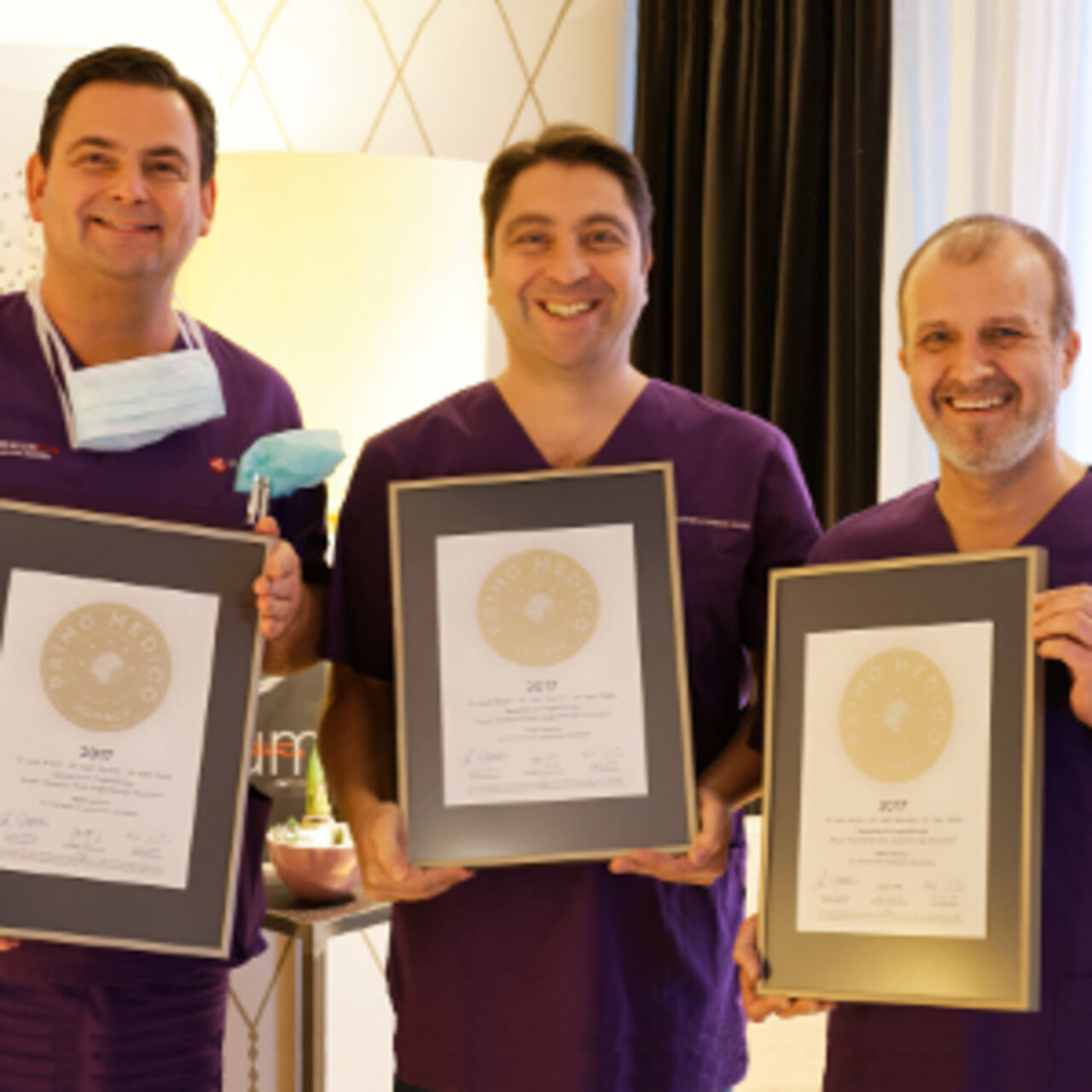Specialists in Trans-PRK
3 Specialists found
Information About the Field of Trans-PRK
What Is Trans-PRK?
Trans-PRK is superficial corneal laser treatment. Surface treatments involve removing the corneal epithelium, the cornea's outermost layer, and ablating the underlying corneal stroma with an excimer laser. Surface treatments include trans-PRK, PRK, LASEK, and Epi-LASEK.
In Trans-PRK, corneal epithelium and corneal stroma are ablated with the excimer laser. Trans-PRK is a further development of PRK in which the surgeon manually removes the epithelium before the corneal tissue is ablated with the excimer laser in a second step. Since both surgical steps are performed with a laser in Trans-PRK, no mechanical manipulation of the cornea is necessary, and the surgical time is shorter. In addition, the method is perceived by patients as less stressful than PRK.
Trans-PRK has been used more widely since the late 1990s but is used much less frequently overall than LASIK. Compared to LASIK, pain after surgery is more common and recovery time is significantly longer because the corneal epithelium must first regenerate after surgery. However, an advantage of Trans-PRK is a greater residual thickness of the cornea after surgery. This makes the surgical method very safe and especially suitable for thin corneas.
For Which Patients Is the Procedure Suitable?
Trans-PRK is suitable for the treatment of mild to moderate myopia. It is mainly considered when LASIK is impossible due to a thin cornea or large pupil. Trans-PRK is also preferred when there is a risk of injury that could cause the flap to detach during LASIK. This is the case, for example, in some professional groups such as police officers or when practicing certain sports.
Trans-PRK is rarely used for farsightedness nowadays. The cornea must be removed in a ring around a center to correct farsightedness. Wound healing takes longer, and adequate correction may not be achieved.
The Refractive Surgery Commission of the German Ophthalmological Society and the Professional Association of Ophthalmologists of Germany has issued the following recommendations:
Trans-PRK can be used for myopia up to -6 diopters and astigmatism up to 5 diopters. Surgery is also possible in simultaneous presbyopia, where one eye is adjusted to distance vision. The other eye is corrected so that the near vision is optimal.
Trans-PRK can be used to a limited extent for myopia up to -8 diopters, astigmatism up to 6 diopters, and hyperopia up to +3 diopters. The Refractive Surgery Commission defines this limit: the procedure can be used, but the results are progressively worse and the side effects more frequent; comprehensive patient informing is necessary.
The surgery must not be carried out for chronic progressive corneal disease, cataract, glaucoma with severe visual field loss, and exudative macular degeneration.
What Does Trans-PRK Cost?
Surgeries to correct refractive errors are not covered by health insurance. For Trans-PRK, you have to calculate costs of 1000 to a maximum of 2000 Euro per eye. Therefore, it is essential to determine in advance which services are included in the price and whether there are additional fees for a follow-up examination.
How Is the Surgery Carried Out?
Before the surgery, the patient may be given a mild sedative. Next, the eye is anesthetized with eye drops containing a local anesthetic and held open with an eyelid retractor. Then the excimer laser is used: corneal epithelium and the underlying tissue are removed in just one step. First, the patient's parameters are entered into the device before the procedure. Next, the laser is adjusted to remove the corneal tissue according to the parameters. The whole process takes only a few minutes per eye.
What Is the Healing Process After the Surgery?
It takes three to four days for the corneal epithelium to reform. During this time, more severe pain may occur because the nerves in the cornea are exposed. Therefore, a contact lens is used for a few days after surgery to protect the open wound. In the first period after the surgery, patients have poorer vision. For example, working on a computer screen is often only possible for two weeks.
During the first few weeks, vision may deteriorate slightly as the pit in the cornea partially fills with corneal tissue again. After about six weeks, the final vision is usually achieved. If the vision has changed too much, it may be necessary to perform another operation.
What Are the Risks?
Superficial scars may form on the cornea. In addition, patients often suffer temporarily from increased dryness of the eyes. The eye dryness can last for weeks. Twilight vision may also be impaired: Patients see light rings around illuminated sources (halos) and shadow images. Extremely rare are infections and severe scarring.
Complications are more likely when significant corrections are needed. In addition, complications are more familiar with farsightedness, such as inadequate correction or scarring.
Which Alternative Laser Surgical Procedures Are Available?
In addition to Trans-PRK, there are other superficial laser procedures: PRK involves mechanical removal of the epithelium, usually with a brush or knife; LASEK uses a particular sharp-edged funnel and alcohol to remove the epithelium. EPI-LASIK is a further development of the method in which the corneal epithelium is not destroyed. Instead, the surgeon pushes the epithelium aside using a microscalpel with a stubby blade and then puts it back over the defect.
As an alternative to superficial laser procedures, methods are available in which the corneal tissue is removed from beneath a superficial layer of the cornea:
In LASIK, the surgeon first partially separates a thin layer from the cornea using a sophisticated microscalpel called a microkeratome and turns it down. Then, corneal tissue is removed from the exposed inner corneal layer utilizing an excimer laser in a second step. The surgeon then turns the corneal piece (flap) back over the defect. Femto-LASIK is a newer form of LASIK. Here, the microkeratome is replaced by the femtosecond laser.
Refractive lenticule extraction (RELEX) uses the femtosecond laser to remove a slice of tissue inside the cornea. In REFLEX FLEX, a tissue slice is created through a double incision with the femtosecond laser. In RELEX SMILE, the tissue disc is removed through two lateral openings.
These methods have the advantage that the recovery time is significantly shorter and usually causes less pain after the surgery. In addition, the vision is often good the day after surgery.
Which Doctors and Centers are Specialists in Trans-PRK?
An expert specializing in laser eye surgery best performs surgical correction for refractive error. Modern refractive surgery procedures now have a high level of quality. The specialized ophthalmologist examines the eye comprehensively, informs the patient, and recommends a suitable method depending on the degree of the refractive error.
We will help you find an expert for your condition. All listed doctors and clinics have been reviewed by us for their outstanding specialization in Trans-PRK and are awaiting your inquiry or treatment request.
Source reference:
- Kohnen, T. (2011) Refraktive Chirurgie. Springer Verlag Berlin-Heidelberg
- Mayer, WJ et al. (2019). Oberflächenverfahren in der refraktiven Chirurgie. Spektrum der Augenheilkunde (2019) 33:134-138
- Kommission Refraktive Chirurgie der Deutschen Ophthalmologischen Gesellschaft und des Berufsverbands der Augenärzte Deutschlands e.V. (2019). Bewertung und Qualitätssicherung refraktiv-chirurgischer Eingriffe durch die DOG und den BVA – KRC- Empfehlungen. Link: www.aad.to/krc/qualit.pdf (27.10.2020)


